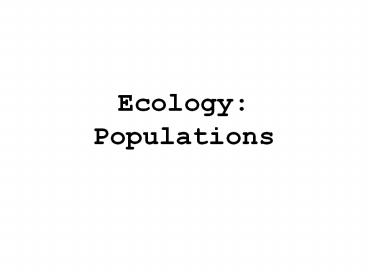Ecology: Populations - PowerPoint PPT Presentation
1 / 23
Title:
Ecology: Populations
Description:
Ecology: Populations Characteristics of Populations Geographic distribution Density Growth Rate Age Structure Geographic Distribution Also called Range Describes the ... – PowerPoint PPT presentation
Number of Views:137
Avg rating:3.0/5.0
Title: Ecology: Populations
1
EcologyPopulations
2
Characteristics of Populations
- Geographic distribution
- Density
- Growth Rate
- Age Structure
3
Geographic Distribution
- Also called Range
- Describes the area inhabited by a population
4
Population Density
- The number of individuals per unit area can vary
tremendously depending on the species its
ecosystem
How many Cacti are there per square kilometer in
this desert?
5
Population Growth
- Three factors that effect population growth
- Number of births
- Number of deaths
- Number of individuals that enter or leave the
population
6
Examples
- What happens if the number of births are greater
than deaths? - What happens if the number of deaths are greater
than the number of births? - Which situation will allow for population growth?
7
Movement within populations
- Immigration - The movement of individuals INTO an
area - Emigration - The movement of individuals OUT OF
an area - Which of these will allow a population to grow?
8
Exponential Growth
- Occurs when the individuals in a population
reproduce at a constant rate - Under ideal conditions with unlimited resources,
a population will grow exponentially
J-shaped curve
9
Logistic Growth
- Occurs when a populations growth slows or stops
following a period of exponential growth - This happens as resources become less available
causing the growth of a population to slow or
stop.
S-shaped curve
10
X number of individualst timeK carrying
capacity
Carrying Capacity - The largest number of
individuals that a given environment can support
K
11
Limiting Factors
- A factor that causes population growth to
decrease such as predation, competition, climate
extremes or human disturbances - Two Types of Limiting Factors
- Density-dependent
- Density-independent
12
Density-dependent
- Limiting only when the population density reaches
a certain level - Biotic factors include competition, predation,
parasitism, disease - Operates most strongly when a population becomes
very large and dense
13
Competion
- When organisms are crowded this causes more
competition - Examples space, food, water, sunlight
- This competition can be between different species
which may lead to evolution to occupy different
niches
14
Predation
- Predator-prey relationships are one of the best
mechanisms of population control
15
Parasitism and disease
- Parasites take nourishment at the expense of the
host - Usually weakens but can cause death
- Similar to predation
16
Density-Independent
- Affect all populations in similar ways regardless
of the population size - Abiotic factors include natural disasters,
seasonal cycles, unusual weather - Can lead to a characteristic crash
- Most populations can adapt to some change
- Some changes can effect entire populations with
major upsets leading to long-term declines
17
Human Population Growth
- Size of human population tends to increase with
time - Human population growth was very slow due to
harsh conditions and limiting factors - High death rates for years
18
Why did population growth increase?
- Life got easier with improvements in industry and
agriculture - Safer food supply
- Improved sanitation
- Improved health care
- Decrease in death rate while birth rate had no
change - Exponential Growth
19
Demography
- Scientific study of human populations
- Birthrates, death rates, and the age structure
help predict countries growth rates
20
Demographic Transition
- The hypothesis as to why population growth has
slowed dramatically in countries such as US,
Japan, and Europe - A dramatic change in birth and death rates
- Historically human societies have had both high
birth and death rates
21
Age Structure Diagrams
- Help predict future population growth
- Bar graph of the number of people in each age
group in the population
22
- United States has a slow but steady growth rate
- What is the shape of Rwandas age structure
diagram? - Indicates that there more young children than
teenagers and more teenagers than adults. - Predicts a population that will double in approx.
30 years
23
Future Population Growth
- Estimated human population by 2050 will be more
than 9 billion. - Human population is still growing exponentially.
- Will it level out to logistic growth?
- How might that happen?































